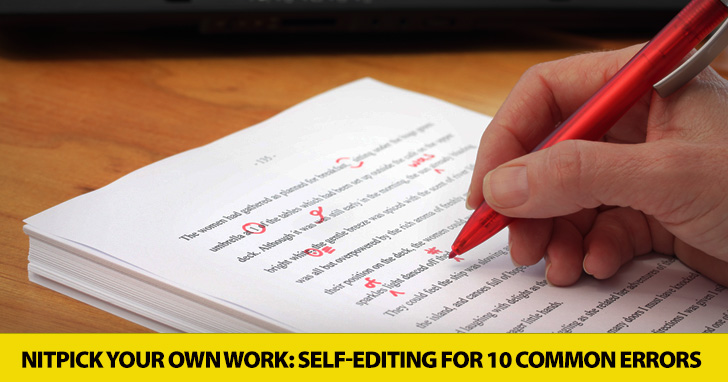She Was Succeeded? She Was Successful? Teaching Self-Editing for Word Form


Indeed, some would say teachers “nitpick" work, or look at work too closely for errors. However, students cannot depend on their teachers forever to check their work before they submit it to a potential employer, newsletter, government agency, etc. Eventually, students have to take responsibility to self-edit. While teachers will not always be there to mark student work, teachers can take the responsibility to help students learn to self-edit so that they can eventually take on the task themselves. There are a number of strategies to teach self-editing and teaching students how to self-edit for these errors so that they can eventually learn to “nitpick” their own work without relying on teachers. The first step in teaching self-editing is teaching students the conventions and “rules” regarding common the most common editing concerns.

Subject-verb agreement is the agreement in person, number, and tense between the subject and verb of a sentence. For example, the sentence “She shops every Sunday” is correct in subject-verb agreement in that the subject, “She” agrees in person, number, and tense with the verb “shops”: in regular English verbs, the third person singular noun takes an “s” or “es” ending in the simple present tense. Subject-verb agreement is a problem for both nonnative and native speakers of English. While nonnative speakers are more likely to make errors such as dropping the “s” in third-person singular (“he go” rather than “he goes”), native speakers will also make this mistake, especially if there is a long element between the subject and verb: e.g., “Jake, who works in the retail industry with his cousins, go to a conference every…” etc. The subject “Jake” and main verb “go” are so far separated in the sentence that making them agree becomes difficult. Another difficulty in judging when to use third person singular is with “mass” or “noncount” nouns: e.g. “The staff go on break at 11 am…” This is incorrect as “staff” is a “mass” or “noncount” noun: e.g., there is a single staff even if composed of many members, so it should be “staff goes.”
Another problem for both nonnative speakers and native speakers is dropping plural endings. Again, while a nonnative speaker is more likely to drop a regular plural ending of “s” or “es,” the native speaker might make mistakes in more complex/irregular plurals: “medium” is in the plural “media” (rather than “mediums”) for example, or “alumnus” in plural form becomes “alumni” (not alumnuses).
Another concern for both native speakers and nonnative speakers of English is parallel structure: making sure that all similar elements are parallel or “line up.”
For example, the sentence “I like to cook, to dance, and writing” is not parallel. I have described three activities I like, but there are two infinitives (“to eat,” and “to dance”) and a gerund (“writing”). “I like to eat, to dance, and to write” is parallel—the three activities are all expressed in the infinitive form.
Again, students of all backgrounds can have problems with comma and semi-colon usage, knowing when to use each. Briefly, a semi-colon can separate two independent clauses (“I am a teacher; I work at the college level). A comma may not separate two independent clauses. “I am a teacher, I work at the college level” is a comma-splice. A comma is not “strong” enough to separate to independent clauses and must be used with a conjunction to separate two independent clauses. “I am a teacher, and I work at the college level” is correct.
Finally, both native and nonnative speakers can make mistakes in end punctuation, such as using a period instead of a question mark: “When will the rain finally come.”
“When will the rain finally come?” is correct. Misuse of exclamation points is also common: “There’s a fire,” he shouted! The exclamation should go directly after the words shouted: “There’s a fire!” he shouted.
We all have our own typical errors in writing, especially in first drafts. Therefore, students should be taught to “nitpick” their own work before the teacher does as it is part of the entire writing process.

To proofread papers for grammar and punctuation rules, students need to know what the rules are to begin with in order to use them: how to locate a subject and verb in a sentence, for example, as well as what independent and independent clauses are, is necessary prior knowledge for understanding a lot of punctuation and grammar use in English. Once students have that basic knowledge, they need to know a few basic rules regarding the use of verb tense, subject-verb agreement, comma usage, and so forth to apply to their own writing. Therefore, explicit instruction in basic grammar and punctuation is needed to begin with.
Reading aloud is very helpful because if the student begins to stumble, to read haltingly, to lose her place, etc., this might indicate something wrong and a need to proofread more closely at the places where reading aloud began to fall apart.
Targeting one’s own “problem areas” in writing is also necessary for self-editing. For example, if a student knows she typically make errors in subject-verb agreement, she should learn how to recognize the subject and verb of a sentence and how to make them agree. She can then go back and check her papers for this specific problem area before turning them in.
Having a friend or classmate read your work is also helpful because another reader is going to have even more problems in reading aloud, or even silently, the portions that need editing, will become confused because he doesn’t have prior knowledge of the writing, and will begin stumbling in the portions of the paper that have errors. The peer does not need formal instruction to give feedback that a paper is confusing, has errors, and so on. Another reader does not have to be a professional editor or writer to offer valuable feedback. If sentences become confusing to a reader, even one without expertise in grammar, this indicates revision is probably needed.
Leaving a piece of written work and not looking at it for a day or two can be very helpful to the editing process. Coming back to a piece of written work with “fresh eyes,” not having seen it for some time, will help the writer look at it more objectively and pick out errors.
The physical act of typing will often highlight errors missed before. Focus on the words and the sentences they occur in is necessary as one types and then errors that might not have been seen before will be noticed.
Teaching students to self-edit is a challenge as it is a difficult exercise even for professional writers. We are often not objective enough about our own work to see its errors. Nevertheless, learning to self-edit is necessary as most of us will not be able to hire an editor, and teachers will not always be there to “nitpick” student work. However, teaching students some strategies such as targeting common errors, reading aloud, having a friend look at the work, and letting the work ‘rest” will all be helpful in teaching students to self-edit so that they may eventually “nitpick” their own work.